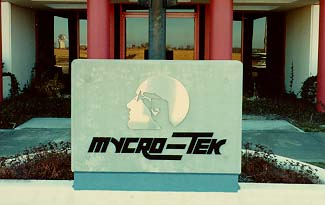 Mycro-Tek, Inc.
Mycro-Tek, Inc. 

 Mycro-Tek, Inc.
Mycro-Tek, Inc. 

A 68020 VME CPU card prototype with floppy, SCSI port, 1 Mb serial I/O
channels, and an IBM keyboard interface was designed by me, and eventually
replaced with a more economical Motorola CPU card. I also designed the video
system, and included a 1024x800 display with 8 shades of grey, a grey-scale
pallette, and a double-buffered architecture for cursor animation. My
demonstration of the animation capability included flying flamingos and a
quilt of eagles. I wrote a 10K graphics software package to test the hardware,
composed on a VAX/VMS and on a VERSADOS system. In addition, I wrote a program
to compute video timing parameters in C for different choices of screen pixel
density. The display was capable of higher resolution, to 1248x1024, using the
same monitor used on SUN workstations. It was offered with software for
display ad composition in a newspaper environment. The 1024x800 pixel density
was appropriate for a pixel-per-point font presentation, giving a fair
representation of of the distance between baselines of type on a digital
monitor. This was the AIM system. It was shown at trade shows and some units
were sold. Higher-speed versions of the 68020 were considered for still higher
performance.
Earlier, I developed the hardware and software for an 8086-based
interactive graphic system, the ADCOMP display ad composition terminal. A
patent was awarded to me for the character generation technique. It was my job
to design the version of the 8086 card that went into the product, and also
the Multibus RAM and PROM cards, and the digital video card with two area
cursors and a cross-hair cursor. The original composition system was written
and perfected by myself and Lisa Powell, who was responsible for testing.
After I left the project Lisa went on with Mike Christianson to enhance the
product. Software accretions slowed the machine down, and the next version,
the AIM system based on the 68020 described in the preceeding section, was
more ergonomical, faster, and more attractively packaged.
Lisa Powell was obliquely memorialized by Apple, which came out
subsequently with LISAs to remind us about sharing credit. Many system
concepts came from Harris and Zenotron. Numerous Mycro-Tek staffers
contributed useful concepts (including Kenny Castor in Sales) and the AdComp
was an exciting product in those days. It was for a time the most profitable
piece of equipment Mycro-Tek produced, per unit. The net volume in the more
conservative editing system for newspapers developed by leading lights Stan
Brannan, Larry Runyan, and Steve Markel was more impressive. AdComp sales
probably amounted to several million dollars.
Also, I developed Multibus dynamic RAM cards with and without error
detection and correction, and a Z80-based micro-winchester disk interface with
DMA. A Multibus EEPROM card was developed by me, together with the printed
circuit artwork. I used PAL logic, and did state machine design. ALso, I
prepared research appers on disk drives, operating systems, and developed a
proposal complete with detailed schematics for a 68000-based system with a
custom memory management unit to support UNIX.
In addition, I developed advanced software for print shops, featuring a
counting keyboard program, and an automatic hyphenation and justification
program. Our first project was a small program to count keyboard keystrokes.
It was used to compute all the keystrokes compositors would make while doing
difficult composition jobs. Later, I developed a translator for reformating
the word processing input of the system into paginated text. Finally, I wrote
a smart editor with horizontal scrolling and other advanced features, and
copy-fitting software. These were large programs that were installed at
several sites. Mycro-Tek marketed this system for print shops nationally,
although it was never as profitable as our system for newspapers.
I wrote some PLM/86 test software before leaving, and studied the C
programming language in connection with a company proposal for installing UNIX
on a hypothetical new system. This new system included a design by me, under
Larry Runyan's supervision, for a complete 68000-based system card set,
including a custom MMU, memory, and peripheral interface cards. It never got
into production because our salesmen decided that UNIX was not user-friendly
enough for our newspaper market.
Instead I went to Kreonite after the sale of Mycro-Tek to Allied Chemical
to work on a system for scanning and printing color photographs and proposed a
color retouching terminal capable of zooming and panning over very large
high-resolution color images with offset registors for horizonal and vertical
scrolling. We also considered flat-bed scanner designs proposed by Dwight
Krehbeil, who held 51% of Mycro-Tek's stock at the time the company was
sold.
(INTEL Chips and systems: 8086, 8080, Zilog Z80 assembly
languages, PLM/86. Digital hardware design, microprocessor applications,
digital video systems, programmable logic
design.)